This website has been archived from TrainWeb.org/hotrail to TrainWeb.US/hotrail.
This website has been archived from TrainWeb.org/hotrail to TrainWeb.US/hotrail.
(Pictures below text)
One note of safety: I asked permission of a circus employee before poking through the yard and getting up close to the circus train equipment. Also note that you are not aloud inside the train without an invitation and escort! To do otherwise is tresspassing and they will have you arrested!
The Ringling Brothers and Barnum & Bailey Circus tours the country constantly by train. Each tour lasts 18 or 19 months, then 4 or 5 months are spent rehersing a new tour. There are two trains and two different tours on the road--the Red Unit and the Blue Unit. With two different shows that last two years each, every city visited gets a different show every year.
While the circus train was stopped in Huntsville, Al in November 1998, I managed to get down to see it a few times. My second time down there, I met an employee named Matt; he was the train plumber. He was filling the fresh water tanks on some of the passenger cars when I met him and talked with him for about an hour and a half.
Matt told me that the train had on plumber, an electrician or two (I forget), a carpenter or two, Trainmaster, Assistant Trainmaster, mechanics--all the maintenance men needed to keep the train running inside and out, both from a railroad aspect and an appartment or small city on wheels aspect. (They can change out bad wheels and even trucks on the passenger cars while on the road!).
The last day the train was in town I also briefly met the Trainmaster and a seamstress with the circus. I also met the local NS signal maintainer, NS's Road Foreman of Engines for the district, and another regional NS manager. The NS people where there while the train was packing up, and getting ready to leave. The Road Foreman of Engines also had to ride in the cab the entire route as the line is not normally cleared for passenger trains.
It was really amazing to watch the circus pack up on their last day in Huntsville (a Sunday). The last show started at 2:00pm, and as soon as someone finished their act, they came back to the train and started to packup. The real packing didn't get started until about 5:00 or so, when the street by the yard was closed by Huntsville City police so the train could block the crossing as the flat cars were loaded and the train made up. It wasn't until about 12:00am until the train finally pulled out of Huntsville that night...
 Click for a full view (44k)
Click for a full view (44k)
These first few shots give you an idea of what the circus train is like. In this photo you can see some flat cars in the foreground and some of the livestock cars in the background. The flat cars are used to haul trailers, small tractors, a few small trucks, and the tigers. (The tigers ride in a trailer or cart on the flats cars). The red and blue automobiles you see belong to circus employees. Employees have the option of riding the train, or following in their car or RV; there are benefits and disadvantages to each:
By car or RV: advantages: more privacy, go at your own pace, can drive arround whatever city you are performing in. Disadvantages: gas and hotel costs, must keep pace with the train.
By train: advantages: free transport, a place to stay--no hotel costs, can move arround on the train. Disadvantage: can't get arround the cities you are performing in.
Anyone who works or has worked for Ringling Brothers, please write in!
 Click for a full view (41k)
Click for a full view (41k)
Here is another angle on the animal cars. Note the ramps--they stow directly under the doors on the underside of the car. Two cars had elephants (6 per car), one had horses, and I think one had zebras...
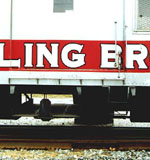 Click for a full view (35k)
Click for a full view (35k)
Here is where the ramps stow.
 Click for a full view (27k)
Click for a full view (27k)
Here we see some fairly typical passengers on the right. The freights on the left were the only freight cars left in Huntsville Yard while the circus train was there--and the yard was very full! Those freights stayed because they were damaged in a derailment a little while before the circus came to town.
The circus train was made up of 55 cars at the time, and was one car short of being a mile long!
 Click for a full view (48k)
Click for a full view (48k)
Still more passenger cars.
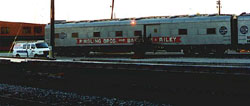 Click for a full view (27k)
Click for a full view (27k)
The animal cars again. Note the Roto-rooter truck--Roto-rooter was contracted to empty the sewage from the retention cars on the underside of the train. It takes quite a bit of planning to move and park the train--trash disposal (dumpsters were brought in for the week), sewage disposal, diesel for the generators, fresh water, hay and feed for animals, food for the people, etc.
 Click for a full view (46k)
Click for a full view (46k)
Here you can see the a flat car with one of the tractors parked on the ramp. These tractors are used to push and pull carts that ride on the flat cars.
 Click for a full view (76k)
Click for a full view (76k)
These two cars look like container cars, but aren't. The trailers have been welded to the frame of the flat cars. (2 trailers per flatcar). The trailers are used to store supplies that cannot be readily re-stocked on the road--like suveniors.
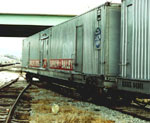 Click for a full view (47k)
Click for a full view (47k)
Here is a more detailed shot of one of the container cars.
 Click for a full view (53k)
Click for a full view (53k)
Notice this picture...
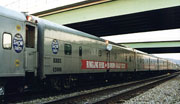 Click for a full view (70k)
Click for a full view (70k)
Now this picture of the same car. The stool is moved, and the satelite dish is out! Later in the evening there were even more dishes put up. This car is a special car as only two people shared it--the Ringmaster and the Band Director; each gets half the car.
 Click for a full view (107k)
Click for a full view (107k)
Here is a look down the mainline. The yellow brick building after the overpass is the Huntsville Depot. You can also see some of the flats and more of the passenger cars. I took this photo from a street crossing.
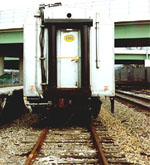 Click for a full view (81k)
Click for a full view (81k)
This is typical of the end of the cars. Notice the yellow safety device so noone steps off the end of the car.
 Click for a full view (70k)
Click for a full view (70k)
This car had more windows than the typical car... I'm not sure why.
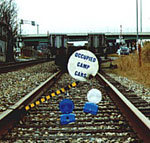 Click for a full view (30k)
Click for a full view (30k)
The all important Blue Flag. A blue flag signifies that people can be on, under, or in the cars behind it and no one is alloud to move the train until the blue flag comes down. Only the person who puts up the blue flag can take it down.
 Click for a full view (38k)
Click for a full view (38k)
Here you can see some of the modifications made by Ringling Brothers--windows that have been welded over. The Ringling shops are near Tampa, Fl. They can do all types of major and minor car repair and renovation there.
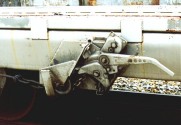 Click for a full view (49k)
Click for a full view (49k)
Here is a detail of the hand brake on the flatcars. It is a ratchet type mechanism.
 Click for a full view (37k)
Click for a full view (37k)
You can see the computer of an employee and resident in this picture. The train is home for these people...
 Click for a full view (77k)
Click for a full view (77k)
Further evidence that the train is home--a pet dog. Scared me half to death first time he barked at me (a BIG dog).
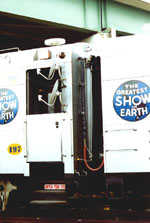 Click for a full view (55k)
Click for a full view (55k)
More satelite dishes. Some cars had 5 dishes on them.
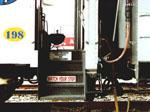 Click for a full view (57k)
Click for a full view (57k)
The grill; more evidence of home on the train.
The no tresspassing sign and watch your step sign are standard in each vestibule.
 Click for a full view (79k)
Click for a full view (79k)
The right half of this car is a workshop. The left half is a genset. There are three generators for the train. Two are normally required, and one is spare. The other two gensets are fully contained in one car.
The workshop pictured above is for the interior of the train--plumbing, electric, carpentry. The is another car whose entirety is dedicated to being a shop for the train itself--wheels, brakes, body, etc.
 Click for a full view (51k)
Click for a full view (51k)
Here is a closeup of the lettering on the side of one of the generator cars. Anyone out there model this train?
 Click for a full view (53k)
Click for a full view (53k)
I don't know why I included this and the above pic... but I did. Maybe they will be helpful to modelers...
 Click for a full view (64k)
Click for a full view (64k)
A closeup of the air intakes (side) and exhaust (square on top of car). Despite this being a generator, the car is amazingly quiet. The car is relatively new and I'm told the old generator cars were terribly loud.
 Click for a full view (78k)
Click for a full view (78k)
This is the restraunt car, as mentioned above. Yes, the food costs money, even to the employees, but I'm told its cheap and very good. In the foreground you can see one of the dumpsters that was brought in for the circus train. Also note NS's maintenance stuff and track parts in the foreground.
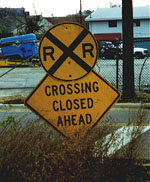 Click for a full view (40k)
Click for a full view (40k)
These signs were put out when the train arrived to unpack, and again when the train was packing to leave.
 Click for a full view (104k)
Click for a full view (104k)
Here you can see the parts for one of the ramps used to load the flat cars.
 Click for a full view (70k)
Click for a full view (70k)
In these last three photos you can see how the flat cars allow tractors and carts to drive from car to car.
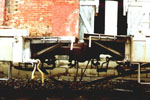 Click for a full view (75k)
Click for a full view (75k)
Thats it! Hopefully I'll someday meet up with the circus train again.
By the way... anyone out there who is wondering, I've been told by residents of the Blue train that it is the better of the two to live on. Anyone from the Red train care to argue the point?!?